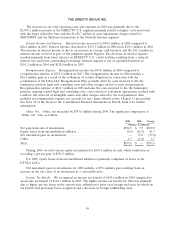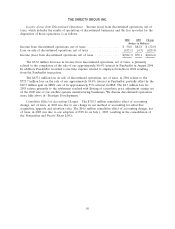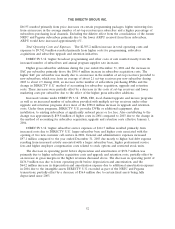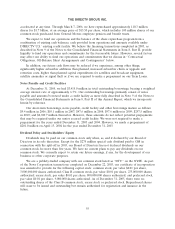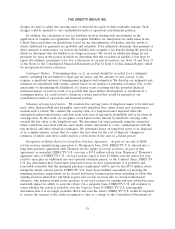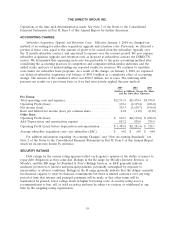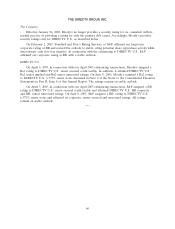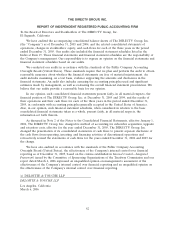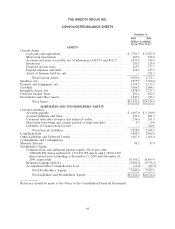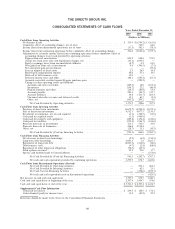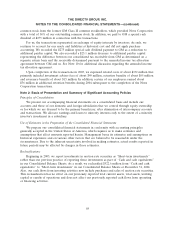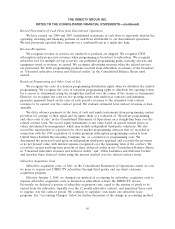DIRECTV 2005 Annual Report Download - page 72
Download and view the complete annual report
Please find page 72 of the 2005 DIRECTV annual report below. You can navigate through the pages in the report by either clicking on the pages listed below, or by using the keyword search tool below to find specific information within the annual report.
THE DIRECTV GROUP, INC.
Operations at the time such determination is made. See Note 3 of the Notes to the Consolidated
Financial Statements in Part II, Item 8 of this Annual Report for further discussion.
ACCOUNTING CHANGE
Subscriber Acquisition, Upgrade and Retention Costs. Effective January 1, 2004, we changed our
method of accounting for subscriber acquisition, upgrade and retention costs. Previously, we deferred a
portion of these costs, equal to the amount of profit to be earned from the subscriber, typically over
the 12 month subscriber contract, and amortized to expense over the contract period. We now expense
subscriber acquisition, upgrade and retention costs as incurred as subscribers activate the DIRECTV
service. We determined that expensing such costs was preferable to the prior accounting method after
considering the accounting practices of competitors and companies within similar industries and the
added clarity and ease of understanding our reported results for investors. We continue to capitalize
costs under our subscriber lease programs. As a result of the change, on January 1, 2004, we expensed
our deferred subscriber acquisition cost balance of $503.9 million as a cumulative effect of accounting
change. The amount of the cumulative effect was $310.5 million, net of taxes. The following table
presents our results on a pro forma basis as if we had retroactively applied this new method:
2005 2004 2003
(Dollars in Millions, Except Per Share
and Per Subscriber Amounts)
Pro Forma:
Total operating costs and expenses .......................... $12,531.9 $13,479.4 $9,599.0
Operating Profit (Loss) .................................. 632.6 (2,119.4) (226.8)
Net income (loss) ...................................... 335.9 (1,638.7) (416.8)
Basic and diluted net income (loss) per common share ........... 0.24 (1.18) (0.30)
Other Data:
Operating Profit (Loss) .................................. $ 632.6 $(2,119.4) $ (226.8)
Add: Depreciation and amortization expense .................. 853.2 838.0 754.9
Operating Profit (Loss) before depreciation and amortization ...... $ 1,485.8 $(1,281.4) $ 528.1
Average subscriber acquisition costs—per subscriber (SAC) ........ $ 642 $ 643 $ 604
For addition information regarding ‘‘Accounting Changes’’ and ‘‘New Accounting Standards,’’ see
Note 2 of the Notes to the Consolidated Financial Statements in Part II, Item 8 of this Annual Report,
which we incorporate herein by reference.
SECURITY RATINGS
Debt ratings by the various rating agencies reflect each agency’s opinion of the ability of issuers to
repay debt obligations as they come due. Ratings in the Ba range for Moody’s Investor Services, or
Moody’s, and the BB range for Standard & Poor’s Ratings Services, or S&P, generally indicate
moderate protection of interest and principal payments, potentially outweighed by exposure to
uncertainties or adverse conditions. Ratings in the B range generally indicate that the obligor currently
has financial capacity to meet its financial commitments but there is limited assurance over any long
period of time that interest and principal payments will be made or that other terms will be
maintained. In general, lower ratings result in higher borrowing costs. A security rating is not a
recommendation to buy, sell, or hold securities and may be subject to revision or withdrawal at any
time by the assigning rating organization.
59


